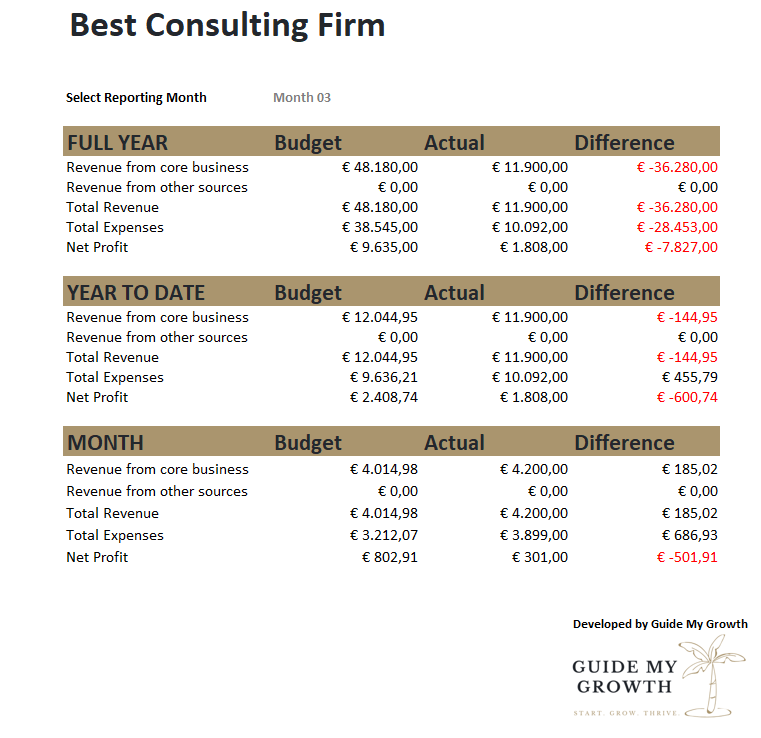For the past few months, I have been working with the CEOs of small companies from 5 countries in Latin America. Every business owner has their own unique challenges and opportunities. But there is one common thread: to thrive - and increase profits for small business - it is important to use effective strategies.
Here are 12 essential strategies to increase profits for small business.
1. Set up a solid budget

The number one thing I look at when I work with a business is their financial position.
Too many businesses don't have a budget even though it is essential for any business.
A budget serves as a financial roadmap. It guides your spending and helps you to allocate resources effectively.
If you take the time to outline your expected income and expenses, you can also use your budget for financial planning.
It will allow you to plan for necessary expenditures like advertising and salaries while also setting revenue targets to cover these costs.
Without a budget, your business operates blindly. This makes it difficult to make informed financial decisions.
This small business budget template can help you get started.
2. Separate business and personal finances
I'm still surprised how many businesses don't keep their business finances fully separate from their personal finances!
Keeping your business and personal finances separate is fundamental if you want to manage your cash flow well.
If you regularly take varying amounts of money out of the business for personal use, this will obviously reduce the resources needed for reinvestment and growth.
A better approach is to pay yourself a salary and manage all personal expenses from your personal account.
It also makes your accounting easier!
Start by making sure that you know all your expenses and then determine which ones - if any - should be moved to your personal account.

3. Understand costs and profit margins
Profit margins is another area where many businesses struggle.
Just yesterday, I was talking to a business in Ecuador that asked me if they should continue working with a certain customer.
In the past, they have made the mistake of investing too much time into a customer, without getting a financial return that justified the time investment.
A new customer had just come in and they wanted to avoid making the same mistake.
So, we looked at customer profitability and profit margins.
To determine the profitability of your product - or service - you need to know the cost of your inputs.
How much does it cost to produce a product? Or to deliver a service?
When you calculate your costs, you need to include the total cost of sales, as well as any additional costs - such as shipping and storage in the case of physical products - to understand the actual cost of production.
It also requires you to understand the difference between gross profit and net profit.
In my client's case, they needed to start keeping better track of the number of hours they spent working for a customer. They also needed to get a better understanding of how to price their service package.
Understanding the actual cost of your product or service helps you focus your efforts on increasing sales of the most profitable products/services. It also helps you decide whether certain products - or services - should be cut.
It even helps you decide whether to say goodbye to certain customers!
This strategic approach helps increase profits for small business by maximising their profit margins.
4. Set competitive and informed prices
It goes without saying that the price of your product or service should 1) cover all costs and 2) reflect the value you provide.
If you cannot charge a viable price because of heavy competition, it may be time to reconsider what you are selling.
Should you stop selling this product?
Can you take steps to increase the perceived value of your product or service so that customers will pay more for it?
Or is this product a lead generator that helps you sell products/services in a higher price range?
Also be very careful with discounts. Always evaluate them carefully to see if they boost sales without eroding your profit margins.
Note: if your product is more high-end, offering discounts can also damage your market position because it devalues your brand.
Note: for service providers, tools like pricing calculators can help you determine viable rates. You may also find this article about pricing strategies useful.
5. Monitor business expenses closely
This one is easy.
Always know what your business is paying for.
Regularly review your expenses, including monthly bills and one-off payments.
Make sure that you are not overpaying for services like banking fees or insurance.
When hiring venues or services, understand what is included in the fees so that you can avoid hidden costs.
Once you have the full overview, also take a minute to see how you can reduce costs.
This vigilance helps control business expenses. It stops money from slipping away and it helps you make sure you are getting the best value for your money.
6. Prioritise customer satisfaction
It is cheaper to retain your existing customers than to acquire new ones.
Satisfied customers are more likely to return for more products. Moreover, they will likely recommend your business to others. And word-of-mouth marketing is the best kind of marketing!
So how can you retain customers?
The quick answer is: always deliver high-quality products and services and solve problems quickly.
If you want a longer answer, you will find this article about customer satisfaction interesting as well as this one about how to retain customers.
This strategy reduces marketing costs and helps increase profits for small business by leveraging existing customer relationships.

7. Choose your customers and partners wisely
Not all customers are good for your business.
Some customers need to be chased before they pay. Others do not pay at all. And then there's also the type of customer who can damage a brand and frighten away the type of customer that you want to attract.
Trust your instincts and be selective about who you do business with.
The same advice applies to choosing a business partner. Choose partners who genuinely add value to your business.
Strategic partnerships can enhance your business operations and boost your business growth.
But always do your due diligence before you join forces with someone.
And know how to say goodbye to a business partner if things don't work out well.
8. Manage growth well
Your business is growing well? Congratulations, that is very exciting!
But remember that growth should be paced carefully.
If you expand too too quickly, you will strain your resources and compromise your quality.
Make sure that your business can consistently handle current responsibilities excellently before you expand to the next level.
Plan for growth by making sure that you have a business growth strategy in place.
This helps you maintain quality and reliability, both of which are critical for long-term profitability.
9. Optimise inventory management
This is for the businesses that sell products.
Effective inventory management is crucial for balancing supply and demand.
Overstocking can lead to high carrying costs and potential write-offs. The opposite, understocking, can result in missed sales opportunities.
Understand your inventory turnover rates and adjust your stock levels accordingly to optimise your profitability.
Inventory management software can also help to provide real-time insights and improve accuracy.
10. Leverage technology and outsourcing
You do not need all the software and applications! Keep things lean!
This is something I keep reminding businesses of.
Only adopt the technology solutions that fit your current business needs. Then upgrade as you grow.
Don't pay for features that you do not need at this time.
Additionally, consider outsourcing non-core functions like administration or IT.
Outsourcing can be more cost-effective than hiring full-time staff for certain tasks.
Administrative work is one of the easiest areas to outsource. It is work that needs to be done, but not necessarily by you. Outsourcing this work frees up time for you to focus on doing what you do best: growing your business.
The same applies to assets.
A co-working space might be a better fit for your business than a fixed office rental. Renting a delivery vehicle for occasional deliveries can be more cost-effective than buying a car.
All the above creates space for you to focus on core business activities while controlling costs.

11. Invest in your team
Your employees are valuable assets.
A motivated and well-informed team can act as ambassadors for your brand and contribute to customer satisfaction and business growth.
So treat them well, train them and align them with your business goals.
This doesn't always mean paying them higher salaries or spending a lot of money on training.
For example, I run an NGO in Liberia called Mineke Foundation. We are a small organisation with big ambitions.
There is no way we can compete on salaries and use that as a strategy to attract the best people.
We therefore invest in other things:
- we pay a fair salary and are fully transparant about why it cannot be increased
- we offer on-the-job training by our international volunteers and actively look for additional ways to build staff capacity locally
- we include all staff - down to the security - in discussions about our plans and activities
- we treat people with respect. For us, this means giving them the freedom to do their work and supporting them as needed, but also expecting full accountability
- we look for ways to appreciate them that are non-financial. When we received a large donation of laptops, we designated a certain number for use by staff who did not necessarily need a laptop. We also brought in a trainer to train staff in digital skills.
Investing in your team increases productivity, builds loyalty and drives profitability. We have seen this to be true at both the NGO and our school.
12. Enhance your marketing efforts
If you want your business to grow, you need effective marketing strategies.
This is another area that I work on with a lot of businesses.
I don't tell them how to create the perfect social media post, but I work with them to identify their Most Profitable Customers, understand the pain points these customers have, design a value proposition specifically for these customers, and then choose the most effective marketing strategies to reach them.
This process often requires some trial and error, because it takes time to really understand customers.
However, spending some time to refine your marketing strategies bring you a significant payoff in terms of increased sales and profitability.
Conclusion
Understanding how to increase profits for small businesses requires a strategic approach that centers around financial management, customer satisfaction and cost control.
Companies that take the time to implement such a strategic approach, see very good rewards in all aspects of their business.




